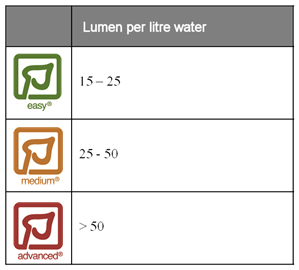Lighting for the planted aquarium
Light is the most important factor when growing aquatic plants. Without it, your plants simply won't be able to grow. Deciding how much light you need over your aquarium depends on the plants you would like to grow, how fast you would like them to grow, whether or not you're injecting CO2 into your aquarium, and how much time your are prepared to dedicate to maintaining your plants.
Certain plants have higher light demands while others have lower demands. Often, the more light demanded, the harder the plant is to grow. Higher light often requires more maintenance too, as your plants will be growing faster leading to increased pruning, fertilization, CO2 demands and water changes.
It is very common that we go overboard with our lighting levels causing the development of nuisance algae. This often leads many hobbyists to encounter problems for many years, and can lead some to quit the hobby altogether.
If you are just starting out, it is easier to opt for a low light aquarium. Your plants will grow slower, but it is much easier to grow healthy plants. Fortunately, most plants will grow under lower lighting, so we always mark the ones that need higher lighting. Lower lighting means less CO2 required and less fertilization. There is also less risk of an algae outbreak!
Types of light
The most common form of aquarium lighting is T8 and T5 fluorescent bulbs. Both are capable of growing plants, however T5's are recommended. T5 bulbs are more powerful, and better suited to growing aquarium plants in a densely planted setup. One full length T5 bulb is often enough to grow most aquarium plants. Plants that have high demands may require two full length T5 bulbs.

LED Lighting is an up and coming form of aquarium lighting, offering fantastic lighting effects, low heat and low running costs.

With the new RGB LED technology, plant colours are better achieved. A LED light can last over 5 years, making them a great investment for your aquarium.

Lighting Intensity Levels
Some aquarium plants require differing amounts of light to survive. The lower light demanding plants are generally the easier to grow, making them the perfect choice for beginners, or for 'low tech/maintenance' aquariums.
Lighting levels using T5 bulbs
Below we have indicated what we consider to be low, medium and high lighting when using T5 bulbs.
This is a rough guide and not set in stone for every aquarium. The distance the light is raised from your plants and the type of lighting you are using should also be factored in.
0.25 Watts per Litre = Low Lighting for easy rated plants
0.50 Watts per Litre = Medium Lighting for medium rated plants
0.80 - 1.0> Watts per Litre = High Lighting for hard rated plants
Lighting levels using LED's
Another method of evaluating your light levels in order to choose the correct plants is to use the following table:

Don't forget, higher lighting requires more fertilisation and CO2 addition. This is because your plants grow quicker under higher lighting intensity, which increases the absorption of CO2 and nutrients. Too much light without the required fertilization and CO2 addition will almost certainly result in a poor plant growth and algae!
A simple way to reduce your lighting intensity is to raise your lighting higher above the surface of the water. Or if this is not possible, disconnect or cover up 1 of your bulbs.
Lighting Durations
Getting the lighting period correct is important in prevention of algae. If your lighting period is too long then you could be asking for algae! It's worth putting your lights on a timer to ensure your plants are getting the same amount of light each day.
Avoid:
-
Setting your lighting period for longer than 8 hours. Most planted aquariums do not need more than 8 hours of light.
-
Setting your lighting period for longer than 6 hours in NEW planted aquarium set-ups. During the first month your lighting period should be shorter to keep away algae while your plants grow in.
Colour Temperatures

The colour of light should be chosen on what looks appealing to the aquarist when viewing the aquarium. The colour of light is measured using the Kelvin rating. Roughly speaking, cool colours are rated over 5000k, and warmer colours are rating below. Daylight is 6500K, which is what many prefer for the planted aquarium. Plants are not overly fussed about the colour of your light in order to grow. It is more important to choose a colour that shows off the natural colour of your plants best, and often comes down to personal taste. Anywhere between 6000K to 8000K provides a pleasant colour output in planted aquariums and will get the best out of your plants.
